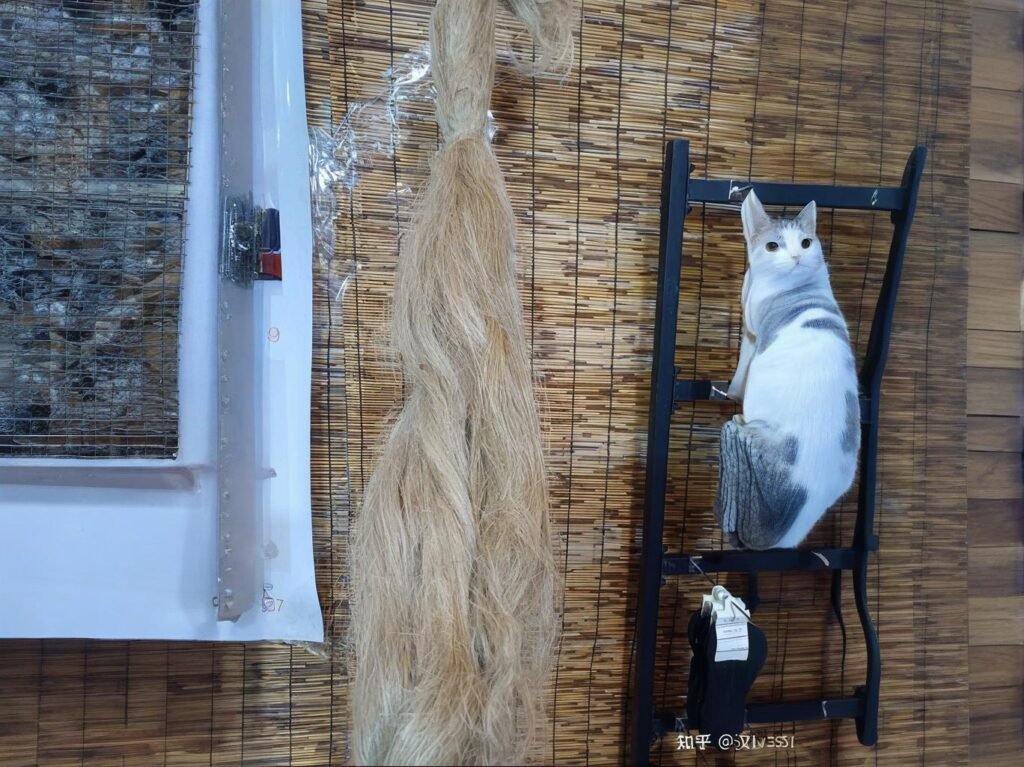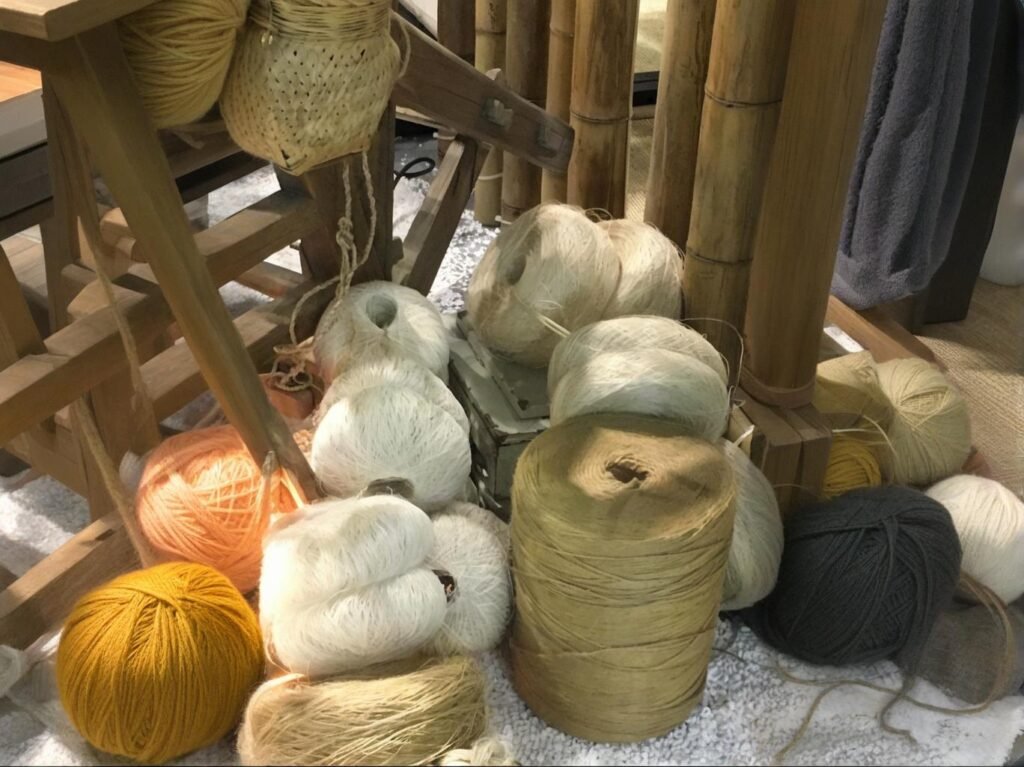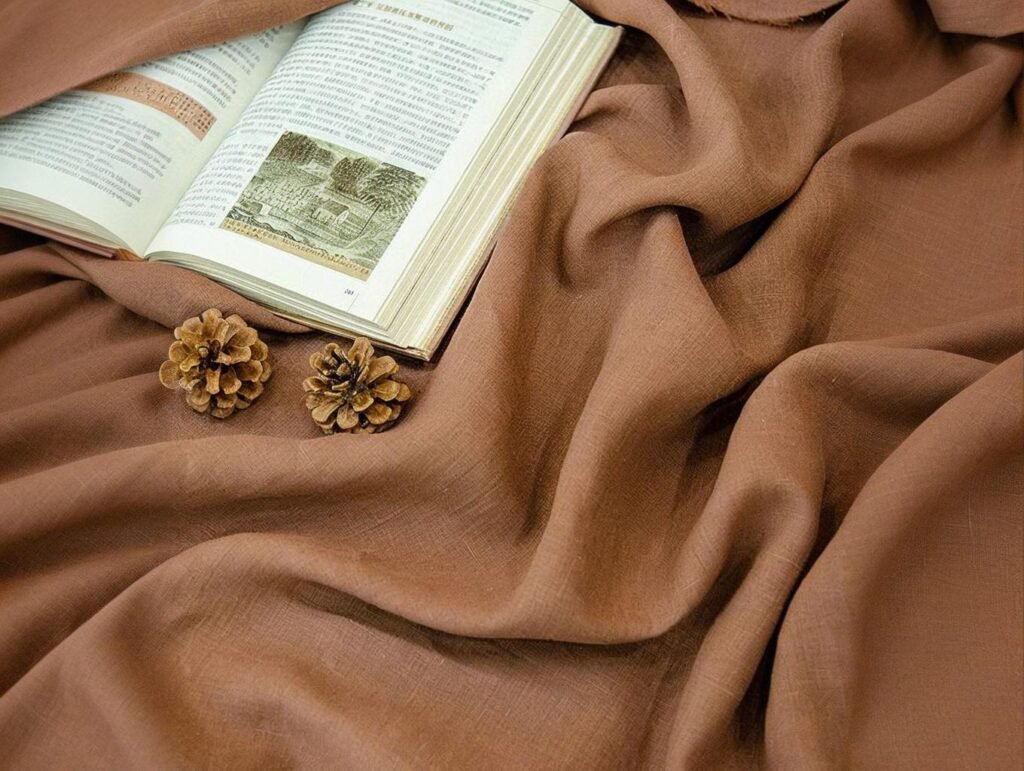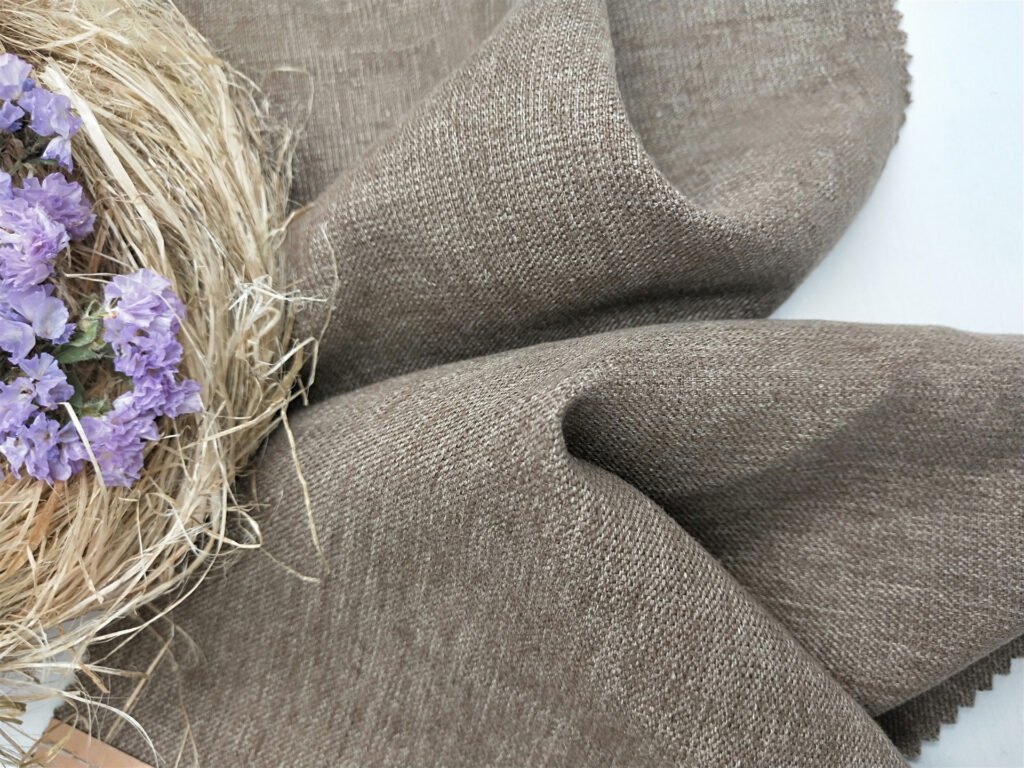
In the quest for high-performance, sustainable textiles, the industry is turning to hemp—an ancient fiber with modern relevance. For decades, cotton and polyester dominated the textile world for their affordability and performance. Linen carved its niche in natural luxury. But hemp is now entering the conversation with a unique promise: superior sustainability, long-lasting durability, and evolving softness.
Hemp material is a natural fiber derived from the stalk of the Cannabis sativa plant, known for its exceptional strength, breathability, UV resistance, and minimal environmental footprint. When compared against cotton, linen, and polyester, hemp stands out for its lifecycle efficiency and balanced textile performance.
Let’s go back to 2019. Patagonia launched a series of hemp-cotton T-shirts and marketed them as tougher, cooler, and better for the planet. Consumers took notice. Fast-forward to today: hemp has found its way into everything from fashion basics to luxury upholstery, but buyers still ask—how does it really compare? And is it worth the investment?
Let’s answer those questions with real-world data and fiber science.
What Is Hemp Material and How Is It Extracted from the Plant?
Hemp material is extracted from the outer bast fibers of the Cannabis sativa plant stalk. Through a process involving retting, decortication, and refining, these strong cellulose fibers are turned into yarn suitable for weaving or knitting into fabric.
From Farm to Fabric – The Hemp Fiber Lifecycle
1. The Plant: Fast-Growing, Low-Input
- Hemp grows to 3–4 meters in just 100 days.
- Requires little to no pesticides or herbicides.
- Can be cultivated on marginal land.
| Attribute | Hemp | Cotton |
|---|---|---|
| Growth Duration | 90–120 days | 150–180 days |
| Pesticide Use | Low | High |
| Water Requirement | 300–500 liters/kg fiber | 10,000–20,000 liters/kg |
2. Retting & Decortication
- Retting: Breaks down pectin binding fiber to the woody core.
- Dew retting (natural, slower)
- Enzyme retting (controlled, faster, sustainable)
- Decortication: Mechanically strips fiber from hurd (core).
- Outputs clean bast fiber for further processing.
3. Cottonization & Spinning
- Cottonization: Shortens and softens hemp fibers to mimic cotton’s spinning behavior.
- Enables use in conventional textile machinery (ring spun, OE).
At SzoneierFabrics, we use enzyme-based cottonization, reducing fiber loss and avoiding harsh chemical softening. Result: faster processing and better softness retention.
How Does Hemp Fabric Perform Compared to Cotton in Strength, Comfort, and Shrinkage?

Hemp fabric is significantly stronger and more durable than cotton, offering better resistance to wear and UV degradation. While cotton is softer initially, hemp softens over time and shrinks less after the first wash.
Comparing Hemp and Cotton Head-to-Head
1. Strength and Durability
| Property | Hemp | Cotton |
|---|---|---|
| Tensile Strength | 3x stronger | Moderate |
| Abrasion Resistance | High | Moderate |
| UV Resistance | Natural protection | Low (yellows in sunlight) |
- Hemp fibers retain structural integrity even after frequent laundering.
- Ideal for workwear, bags, jeans, and long-wear textiles.
2. Comfort and Feel
| Factor | Hemp | Cotton |
|---|---|---|
| Initial Hand Feel | Crisp or slightly coarse | Soft and smooth |
| After 5 Washes | Softens naturally | May pill depending on grade |
| Skin Irritation | Hypoallergenic | Hypoallergenic |
- Cotton is more immediately comfortable; hemp gains comfort through washing and wear.
- For premium applications, hemp-cotton blends balance both.
3. Shrinkage and Dimensional Stability
| Test Type | Hemp Fabric | Cotton Fabric |
|---|---|---|
| Shrinkage After Wash | \~2–3% | \~4–7% |
| Wrinkle Resistance | Moderate | Low |
| Shrinkage Control | Excellent in blends | Poor without finish |
- Hemp’s structure is more stable under heat and moisture stress.
- This makes it ideal for home textiles (towels, curtains) and industrial uniforms.
A Canadian uniform manufacturer replaced 100% cotton shirts with 55/45 hemp-cotton blends from Szoneier. They reported a 35% drop in product returns due to shrinkage within the first six months.
What Are the Key Differences Between Hemp and Linen in Texture and Durability?
While hemp and linen both come from bast fibers, hemp is generally stronger and coarser in texture, while linen offers a softer hand feel and a more refined drape. Hemp is more durable over time and better suited for high-wear applications, while linen is favored for luxury and softness.
Hemp vs. Linen in Design, Performance, and Production
1. Botanical and Structural Origins
| Attribute | Hemp | Linen |
|---|---|---|
| Plant Type | Cannabis sativa (bast fiber) | Flax (bast fiber) |
| Fiber Length | Long (up to 2 meters) | Long but shorter than hemp |
| Fiber Texture | Coarse, crisp | Smoother, silky |
- Both are bast fibers but differ in pectin and lignin content, which affects texture and flexibility.
- Linen is more delicate and high-maintenance; hemp is more rugged and forgiving.
2. Drape and Wrinkle Behavior
| Property | Hemp | Linen |
|---|---|---|
| Drape Quality | Moderate (structured) | Excellent (flowy) |
| Wrinkle Resistance | Moderate (better in blends) | Wrinkles easily |
| Best Use | Structured garments, bags | Blouses, tablecloths, scarves |
- Hemp is preferred for structured silhouettes; linen is ideal for flowy, breathable designs.
- Both soften over time, but linen softens faster with fewer washes.
3. Durability and Lifecycle Strength
| Test Metric | Hemp | Linen |
|---|---|---|
| Tear Strength | Higher | Lower |
| UV Resistance | Superior | Moderate |
| Mold/Mildew Resistance | High | High |
For brands seeking rugged luxury, hemp-linen blends are a winning formula. At SzoneierFabrics, our 60% hemp / 40% linen blend is popular for high-end menswear and eco-luxury accessories.
How Does Hemp Stack Up Against Polyester in Moisture Management and Longevity?

Hemp outperforms polyester in breathability, moisture-wicking, and long-term biodegradability, while polyester excels in stretch and cost efficiency. For eco-conscious performance applications, hemp blends offer a strong alternative to fully synthetic fibers.
Hemp vs. Polyester – Function vs. Sustainability
1. Moisture Management and Breathability
| Feature | Hemp | Polyester |
|---|---|---|
| Moisture Wicking | Excellent | Moderate (traps sweat odor) |
| Breathability | High | Low |
| Thermal Regulation | Good (cool in heat) | Poor |
- Hemp naturally regulates body temperature and keeps the skin dry.
- Polyester can trap sweat and heat, though performance finishes help mitigate this.
2. Stretch, Elasticity, and Performance
| Performance Factor | Hemp | Polyester |
|---|---|---|
| Stretch/Elasticity | Low (unless blended) | High |
| Recovery After Stretch | Poor | Excellent |
| Ideal Uses | Outerwear, yoga blends | Sportswear, activewear |
- Hemp needs to be blended with spandex or polyester for applications like leggings, sports bras, or active tops.
- Polyester still dominates high-stretch markets but loses out in eco scores.
3. Durability and Color Retention
| Property | Hemp | Polyester |
|---|---|---|
| Colorfastness (dyed) | Good (requires pre-treat) | Excellent (holds bright color) |
| UV Resistance | Excellent | Excellent |
| Fabric Aging (pilling, wear) | Minimal | Moderate to high over time |
Polyester is oil-based and non-biodegradable. A single polyester shirt can take 200+ years to decompose, while hemp decomposes in less than 60 days under composting conditions.
4. Environmental Scorecard
| Factor | Hemp Fabric | Polyester Fabric |
|---|---|---|
| Biodegradability | Yes | No |
| Microfiber Pollution | None | High |
| Energy Consumption | Low | High |
| Lifecycle Emissions | Very Low | Very High |
A 2023 report by Textile Exchange estimated that switching 25% of polyester-based T-shirts to hemp blends could reduce industry-wide CO₂ emissions by 11.8 million tons annually.
Which Environmental Metrics Prove Hemp Is More Sustainable Than Other Fibers?
Hemp consistently ranks as one of the most sustainable natural fibers based on water usage, pesticide dependency, land efficiency, carbon sequestration, and biodegradability. Compared to cotton, linen, and polyester, hemp leads across almost every key environmental metric.
Environmental Scorecard for B2B Textile Decision-Makers
1. Water Footprint
| Fiber Type | Water Use (Liters per Kg of Fiber) | Source |
|---|---|---|
| Hemp | 300–500 | FAO, 2023 |
| Cotton | 10,000–20,000 | WWF, 2022 |
| Linen (Flax) | 2,700–4,000 | European Flax Org |
| Polyester | <100 (synthetic) | But fossil fuel based |
- Hemp is often rain-fed and rarely needs irrigation.
- Cotton, by contrast, is the world’s thirstiest crop for textiles.
2. Pesticides and Chemical Inputs
| Fiber Type | Pesticide Use | Fertilizer Use | Runoff Impact |
|---|---|---|---|
| Hemp | Very Low | Low | Minimal |
| Cotton | High (16% global use) | High | High |
| Polyester | None (synthetic) | N/A | High (microfiber) |
- Hemp naturally resists pests and grows well without chemicals.
- Organic certification (like GOTS) ensures complete traceability.
3. Carbon Sequestration and Land Use
- Hemp can absorb 10–15 tons of CO₂ per hectare, often more than trees.
- One hectare can produce 2–3 crops per year in temperate zones.
| Metric | Hemp | Cotton | Linen | Polyester |
|---|---|---|---|---|
| CO₂ Absorption (tons/ha) | Up to 15 | 1.8–3 | \~3 | 0 (emits CO₂) |
| Crop Cycles/Year | 2–3 | 1 | 1 | N/A |
4. Biodegradability and Microfiber Pollution
- Hemp is 100% biodegradable in industrial composting in less than 8 weeks.
- Polyester releases microplastics with every wash—up to 700,000 fibers per load.
For buyers targeting zero-waste or circular production goals, hemp offers superior lifecycle metrics compared to all other common textile fibers.
Is Hemp Easier to Dye and Blend Than Cotton, Linen, or Polyester?

Hemp can be dyed and blended effectively—especially when cottonized or enzyme-softened. It absorbs reactive and natural dyes well and blends seamlessly with cotton, polyester, linen, and spandex, enabling both technical and fashion applications.
Processing Behavior of Hemp in Dyeing and Blending
1. Dye Affinity and Color Performance
| Dye Type | Hemp Compatibility | Notes |
|---|---|---|
| Reactive Dyes | Excellent | Vibrant colors, ideal for apparel |
| Pigment Dyes | Good | Slightly muted tones, eco options |
| Natural Dyes | Excellent | Supports botanical dye programs |
| Acid Dyes | Not compatible | Protein-based fibers only (e.g., wool) |
- Requires pre-treatment for optimal penetration.
- Enzyme softening improves both softness and dye uniformity.
2. Blending Behavior with Other Fibers
| Blend Type | Use Case | Resulting Properties |
|---|---|---|
| Hemp + Cotton | T-shirts, shirts | Breathable, softer hand feel, improved shrink |
| Hemp + Polyester | Bags, uniforms | Durable, colorfast, semi-sustainable |
| Hemp + Linen | Eco-luxury apparel, bedding | Soft, breathable, moisture-wicking |
| Hemp + Spandex | Athleisure, fitted clothing | Comfort stretch + sustainability |
- Cottonized hemp fibers match the staple length of conventional cotton yarns.
- Ideal for spinning with open-end or ring-spun systems.
At SzoneierFabrics, we use low-impact reactive dyeing on hemp blends with GOTS-approved dyes, ensuring color vibrancy without heavy metals or toxins.
3. Surface Treatment Compatibility
- Hemp is compatible with:
- Wrinkle-resistant finishes
- Moisture-wicking coatings
- Flame-retardant treatments (for industrial use)
- Antimicrobial washes (popular in yoga and wellness apparel)
4. Printability
- Hemp fabrics support:
- Screen printing (most common)
- Block printing (artisanal markets)
- Digital reactive printing (for fast fashion)
A French DTC brand launched a digitally printed hemp-cotton tee line using Szoneier fabric. Their re-order rate exceeded 60% in just 90 days due to low shrinkage, bold color retention, and customer feedback praising “eco soft comfort.”
What Fiber Properties Make Hemp Ideal for Specific Apparel or Home Textile Applications?
Hemp’s fiber properties—high tensile strength, excellent breathability, UV resistance, and moisture-wicking capabilities—make it ideal for applications ranging from workwear and casual apparel to towels, curtains, bags, and upholstery. Its versatility allows it to be used alone or blended to achieve varied aesthetics and functionalities.
Matching Hemp Properties to Product Applications
1. Workwear & Utility Garments
| Desired Properties | Hemp Advantages |
|---|---|
| Durability | 3x stronger than cotton |
| UV Resistance | Built-in protection for outdoor use |
| Shape Retention | Shrinks less, holds structure |
| Abrasion Resistance | Ideal for high-friction environments |
- Blends with polyester enhance wrinkle resistance and colorfastness.
- Used in factory uniforms, artisan aprons, field vests.
2. Everyday Apparel
- T-Shirts, Shirts, Lounge Sets: Hemp-cotton blends (55/45 or 70/30)
- Soft feel, breathability, and long-term wear without pilling.
- Hemp’s antimicrobial nature reduces odor buildup.
3. Athleisure and Activewear
| Requirement | Hemp-Based Solution |
|---|---|
| Stretch | Hemp + spandex (5–10%) |
| Sweat Management | Excellent wicking + quick drying |
| Eco Appeal | High among Gen Z and millennials |
- Ideal for yoga pants, wellness wear, and sustainable sports gear.
4. Home Textiles
- Towels, Napkins, Table Linens:
- High absorbency (more than cotton)
- Naturally antimicrobial
- Strong even when wet
- Curtains, Upholstery, Cushion Covers:
- Structural stability
- Natural texture and earthy aesthetic
- UV and mildew resistant
Hemp-linen or hemp-rayon blends give a luxurious drape with added durability—popular in eco-resorts and boutique hotels.
5. Accessories & Bags
- Pure hemp canvas or hemp-poly blends are great for:
- Tote bags
- Backpacks
- Cosmetic cases
- Strength-to-weight ratio makes hemp ideal for load-bearing products.
How Can Textile Buyers Choose the Right Hemp Blend Based on Performance Goals?

Textile buyers can select the ideal hemp blend by considering end-use function, hand feel, cost, sustainability targets, and required technical finishes. By balancing fiber ratios and weave types, hemp fabrics can be tailored for luxury, durability, breathability, or stretch.
Hemp Blend Selection Strategy for B2B Orders
1. For Soft, Everyday Apparel
| Blend Composition | Ideal For |
|---|---|
| 55% Hemp / 45% Cotton | T-shirts, dresses, lightweight knits |
| 70% Hemp / 30% Cotton | Shirts, blouses, workwear tops |
| Hemp / Bamboo Viscose | Loungewear, robes, intimate wear |
2. For Structured or Rugged Products
| Blend Composition | Ideal For |
|---|---|
| 100% Hemp Canvas | Bags, jackets, home upholstery |
| Hemp / Polyester (60/40) | Uniforms, promotional totes, aprons |
| Hemp / Linen | Blazers, curtains, luxury tableware |
3. For Stretch or Activewear
| Blend Composition | Ideal For |
|---|---|
| Hemp / Spandex (5–8%) | Yoga pants, leggings, fitted tops |
| Hemp / Organic Cotton / Lycra | Athleisure, recovery apparel |
SzoneierFabrics provides custom GSM, weave, and blend configurations starting at 100 meters per color or 50 pieces per style, enabling small-to-medium brands to test multiple combinations affordably.
4. Decision-Making Checklist for Hemp Fabric Buyers
- ✅ What’s the product’s primary function (comfort, durability, stretch)?
- ✅ Does it need to meet eco-certifications (GOTS, OEKO-TEX)?
- ✅ Do you need specific finishes (wrinkle-free, antimicrobial)?
- ✅ What MOQ and lead time can your business accommodate?
- ✅ What fabric hand feel or visual finish is desired?
Ready to Build a Smarter Hemp Sourcing Strategy?
Hemp is more than a buzzword—it’s a high-performance, sustainable solution for the future of textiles. Whether you’re designing eco-friendly basics, building long-lasting workwear, or sourcing natural home fabrics, hemp can meet your technical needs without compromising on environmental goals.
At SzoneierFabrics, we make it easy for textile buyers to explore hemp’s full potential:
- ✅ Wide range of hemp blends and weaves
- ✅ Custom development starting at 100 meters
- ✅ Fast sampling and low-MOQ production
- ✅ GOTS, OEKO-TEX, and OCS certification support
- ✅ Free fabric consultation and swatches for qualified buyers
We’ve helped fashion startups, furniture makers, and sustainability-focused brands bring their hemp products to life—with short lead times and long-term reliability.
👉 Contact SzoneierFabrics today for samples, a custom quote, or a consultation with our textile team. Let’s create better, cleaner, and smarter fabric solutions—together.

